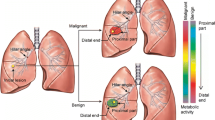Abstract
Purpose.
This study was done to analyse the additional morphological and functional information provided by the integration of [18F]-2-fluoro-2-deoxy-D-glucose positron emission tomography ([18F]-FDG-PET) with contrast-enhanced multidetector computed tomography (MDCT) in the characterisation of indeterminate solitary pulmonary nodules (SPNs).
Materials and methods.
Fifty-six SPNs, previously classified as indeterminate, were evaluated using a Discovery ST16 PET/CT system (GE Medical Systems) with nonionic iodinated contrast material and [18F]-FDG as a positron emitter. Images were evaluated on a dedicated workstation. Semiquantitative parameters of [18F]-FDG uptake and morphological, volumetric and densitometric parameters before and after contrast administration were analysed. Results were correlated with the histological and follow-up findings.
Results.
Twenty-six SPNs were malignant and 30 were benign. Malignant lesions at both PET/CT and histology had a mean diameter of 1.8±1.2 cm, a volume doubling time (DT) of 222 days, a mean standardized uptake value (SUV) of 4.7 versus 1.08 in benign lesions and a mean postcontrast enhancement of 44.8 HU as opposed to 4.8 HU in benign nodules. Malignant lesions had a significantly shorter doubling time and significantly greater postcontrast enhancement compared with benign nodules. Based on the SUV and using a cut-off value of >2.5, PET/CT had a sensitivity of 76.9%, specificity of 100%, diagnostic accuracy of 89.2%, positive predictive value (PPV) of 100% and negative predictive value (NPV) of 83.3%. Based on doubling time (cut off <400 days), it had a sensitivity of 76.9%, specificity of 93.3%, accuracy of 85.7%, PPV of 90.9% and NPV of 82.3%. Based on postcontrast enhancement (cut off >15 HU), it had a sensitivity of 92.3%, specificity of 100%, accuracy of 96.4%, PPV of 100% and NPV of 93.7%.
Conclusion.
PET/CT allows accurate analysis of anatomical/morphological and metabolic/functional correlations of SPN, providing useful data for identifying and locating the disease, for differentiating between malignant and benign nodules and for establishing the aggressiveness and degree of vascularity of pulmonary lesions. Therefore, partly in view of the considerable reduction in time and cost of the single examinations, we believe that PET/CT will gain an increasingly dominant role in the diagnostic and therapeutic approach to lung cancer, especially in the preclinical phase.
Similar content being viewed by others
Author information
Authors and Affiliations
Corresponding author
Rights and permissions
About this article
Cite this article
Orlacchio, A., Schillaci, O., Antonelli, L. et al. Solitary pulmonary nodules: morphological and metabolic characterisation by FDG-PET-MDCT. Radiol med 112, 157–173 (2007). https://doi.org/10.1007/s11547-007-0132-x
Received:
Accepted:
Published:
Issue Date:
DOI: https://doi.org/10.1007/s11547-007-0132-x




